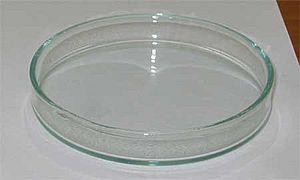Julius Richard Petri facts for kids
Quick facts for kids
Julius Richard Petri
|
|
|---|---|

Petri, c. 1888
|
|
| Born | 31 May 1852 Barmen, Westphalia, Kingdom of Prussia, German Confederation
|
| Died | 20 December 1921 (aged 69) |
| Nationality | Prussian |
| Citizenship | German |
| Scientific career | |
| Fields | Bacteriologist, military physician, surgeon |
| Institutions | Kaiserliches Gesundheitsamt, Göbersdorf sanatorium , Museum of Hygiene, Kaiserliches Gesundheitsamt |
Julius Richard Petri (born May 31, 1852 – died December 20, 1921) was a German scientist who studied tiny living things called microbes. He is famous for inventing the Petri dish, a special container used to grow bacteria and other microorganisms. He came up with this invention while working with another famous scientist, Robert Koch.
Contents
Life and Career of Julius Richard Petri
Petri was born in Barmen, Germany, on May 31, 1852. His family was known for being scholars. His father, Philipp Ulrich Martin Petri, was a professor. His grandfather, Viktor Friedrich Leberecht Petri, was also a director and professor.
Petri's Education and Early Work
Petri first studied medicine at the Kaiser Wilhelm Academy for Military Physicians from 1871 to 1875. He earned his medical degree in 1876. He continued his studies at the Charité Hospital in Berlin. There, he earned his doctorate for his work on the chemistry of protein urine tests.
He worked as a military doctor until 1882. After that, he continued as a reservist. In 1886, he became a curator at the museum of hygiene. Later, he studied under the famous bacteriologist Robert Koch. Petri retired in 1900 but continued to advise the government until he passed away.
Inventing the Petri Dish
From 1877 to 1879, Petri worked at the Imperial Health Office in Berlin. He was an assistant to Robert Koch, a very important scientist in the field of bacteria.
In Koch's lab, they started growing bacteria on agar plates. This idea came from Angelina Hesse, the wife of another assistant. Petri then invented the standard culture dish, which we now call the Petri dish. He also improved the way agar cultures were used. This helped scientists to grow pure groups of bacteria from single cells. This invention was a big step forward. It made it easier to find out which bacteria caused specific diseases.
Petri's first wife, Anna Riesch, passed away in 1894. In 1897, he married Elizabeth Turk.
Importance of the Petri Dish and Discoveries
Petri dishes are very important tools for studying microbiology. They are used to grow microorganisms like bacteria and fungi. A warm liquid mixture, called agar, is poured into the dish. This agar contains special ingredients like nutrients, salts, and sometimes even antibiotics. Once the agar cools and becomes solid, the dish is ready.
How Scientists Use Petri Dishes
Scientists add a sample containing microbes to the dish. This process is called "inoculation" or "plating." For growing viruses, a two-step process is needed. First, bacteria are grown, and then the virus is added to infect them.
A common way to spread bacteria on a dish is called "streaking." A sterile plastic stick or a wire loop is used. The loop is heated to make it sterile. It picks up a sample and makes a streak on the agar. Then, a new stick or sterilized loop is used to spread the bacteria from the first streak. This is repeated a few times. This method helps to separate individual bacterial cells. These isolated cells can then grow into single, pure groups called "clonal colonies."
Keeping Cultures Safe
Petri dishes are often stored upside down. This means the agar is on the top. This helps to stop dust or other airborne particles from falling onto the culture. It also prevents water condensation from dripping onto the microbes. This keeps the cultures clean and safe from unwanted germs.
Before Petri's invention, scientists struggled to keep their cultures free from dust and other bacteria. They used heavy bell jars, but these were not very effective. In 1887, Petri created transparent plates that were slightly larger than his dishes. These acted as transparent lids. This simple design has not changed much since then.
Petri's Later Work and Publications
After his work with Robert Koch, Petri left the lab. He managed the Göbersdorf sanatorium, a hospital for tuberculosis patients, from 1882 to 1885. In 1886, he became the director of the Museum of Hygiene in Berlin.
Petri was not only an inventor but also a prolific writer. He published 150 papers on bacteriology and hygiene. These papers shared many new ideas and information. For example, in a paper from 1876, he explored how proteins found in urine could help identify health conditions. His work greatly helped our understanding of microbiology.
Works
- Attempts at the chemistry of proteins. 1876.
- Methods of modern bacteria research (in: Collection Exoteric Scientific Lectures). 1887.
- The danger of carbon soda furnaces. 1889.
- Industrial hygiene. 1890.
- Experiments on the spread of contagious diseases, especially tuberculosis, by the railway and on measures to be taken. 1893.
- The microscope. From its beginnings to the present perfection. 1896.
- A judgment of high – pressure Pasteurising apparatus 1897.
- Towards quality testing in butter and milk. 1897.
- Apparatus for determination of water content in milk by distillation in a vacuum.
Tributes
On May 31, 2013, Google celebrated Julius Richard Petri's 161st Birthday with a special doodle on their homepage.


